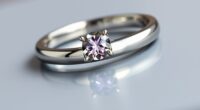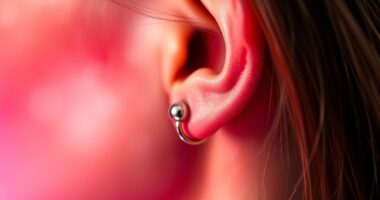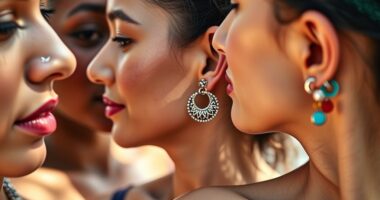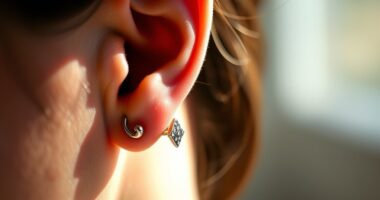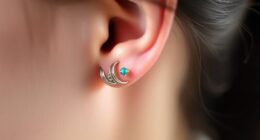People pierce themselves to express their culture, identity, and individuality. It’s a way to connect with heritage, mark important milestones, or stand out from societal norms. Piercings can also boost confidence, help reclaim control over your body, or symbolize rebellion and creativity. They serve as visible markers of belonging or personal values. If you want to explore how piercing influences self-perception and social bonds, there’s more to discover on this fascinating subject.
Key Takeaways
- Piercings serve as symbols of cultural identity, heritage, and social belonging.
- They allow personal expression, challenging norms and showcasing individuality.
- Piercings fulfill psychological needs for self-acceptance, empowerment, and healing.
- They act as markers of social status, group affiliation, or rebellion.
- Piercings reinforce connections to cultural roots and personal values through aesthetic and ritual significance.

Piercing is more than just a fashion statement; it reflects complex psychological and sociological factors that influence why people choose to adorn themselves in this way. One of the key reasons is the desire to express your cultural identity. For many, piercings serve as a powerful symbol of belonging to a particular community or heritage. In some cultures, specific piercings carry deep historical or spiritual significance, marking rites of passage or social status. When you get pierced in these traditions, you’re not just adding decoration—you’re connecting with your roots and affirming your place within a larger cultural narrative. This act of cultural expression can foster a sense of pride and continuity, especially in a world where identity is increasingly fluid and diverse. It’s a deliberate choice to celebrate your background, beliefs, or traditions through your appearance.
At the same time, piercing acts as a form of personal expression. You may use it to showcase your individuality, challenge societal norms, or simply to feel more authentic. When you decide on a specific piercing, you’re making a statement about who you are or who you want to be. It’s a way to communicate your personality without words, whether through subtle earrings or bold facial jewelry. Piercings allow you to break free from conventions, emphasizing your uniqueness and empowering you to control how others perceive you. They can symbolize rebellion, confidence, or creativity—depending on your intent. In this way, piercing becomes a visual extension of your identity, giving you a permanent or semi-permanent way to stand out or find solidarity with like-minded individuals.
Psychologically, piercing can also fulfill a need for self-acceptance or healing. For some, it’s a way to reclaim their bodies after trauma or to mark personal milestones. The process of choosing a piercing, and the subsequent care, can provide a sense of control and agency, helping you feel more grounded. Additionally, the aesthetic appeal and the ritualistic aspect of getting pierced can trigger feelings of empowerment and satisfaction. It’s not just about how others see you; it’s about how you see yourself. Whether driven by cultural roots or personal motivation, piercing acts as a tangible reflection of your inner identity, serving as a reminder of your values, experiences, and aspirations. Recognizing the importance of natural materials in this process can enhance the authenticity and connection to cultural traditions. By understanding these psychological and sociological layers, you recognize that piercing is more than skin deep—it’s a vivid expression of who you are and where you belong.
Frequently Asked Questions
How Does Peer Pressure Influence Piercing Choices?
Peer influence and social conformity strongly impact your piercing choices. When your friends get piercings, you might feel pressured to follow suit to fit in or gain acceptance. This desire to conform can lead you to make decisions based on what others do, rather than your own preferences. As a result, your piercing choices become shaped by social influences, sometimes overriding your personal style or comfort.
Are Certain Piercings Linked to Specific Cultural Backgrounds?
Yes, certain piercings are linked to specific cultural backgrounds. You might notice cultural symbolism in traditional piercings that represent rites of passage or social status. These piercings also serve as aesthetic expressions, reflecting cultural identity and values. By choosing these styles, you connect with your heritage or community, showcasing your unique identity through meaningful adornment that combines cultural symbolism with personal aesthetic expression.
Can Piercing Help Improve Self-Esteem or Body Image?
Piercing can boost your self-esteem and improve your body image by serving as a form of body modification and self-expression. When you choose a piercing that resonates with your personality or style, it helps you feel more confident and authentic. This act of personalizing your appearance allows you to take control of your body image, making you feel empowered and more comfortable in your own skin.
How Do Personal Trauma or Experiences Affect Piercing Decisions?
Your personal trauma or experiences can profoundly influence your piercing decisions as a form of identity expression and trauma healing. You might choose piercings to reclaim control or symbolize overcoming hardship. These choices help you process emotions, express resilience, and reshape how you see yourself. Piercings become a meaningful tool, allowing you to transform pain into empowerment while fostering a sense of healing and self-awareness.
What Role Does Media Play in Shaping Piercing Trends?
Imagine a canvas painted with vibrant hues, where media acts as your brush, shaping piercing trends like tattoo symbolism in the fashion industry. You see celebrities and influencers flaunt daring piercings, turning them into symbols of rebellion or elegance. This visual storytelling inspires you to adopt similar styles, making media your guide in transforming personal expression into a shared cultural language. It’s a powerful force that molds your piercing choices.
Conclusion
As you reflect on why people pierce, you can see it as carving your own story into the canvas of life, each piercing a bold stroke of identity. It’s like jewelry that catches the light, revealing parts of yourself you want to highlight or hide. In this dance between psychology and sociology, your choices become a mirror—shimmering, complex, and uniquely yours—transforming your body into a living affirmation of self-expression.


